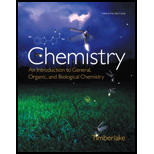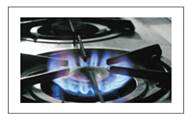
Concept explainers
Methane is a major component of purified natural gas used for heating and cooking. When 1.0 mole of methane gas burns with oxygen to produce carbon dioxide and water, 883 kJ is produced. Methane gas has a density of 0.715 gIL at STP. For transport, the natural gas is cooled to —163 C to form liquefied natural gas (LNG) with a density of 0.45 g/mL. A tank on a ship can hold 7.0 million gallons of LNG. (2.1, 2.7, 3.4, 6.7, 6.9, 7.7, 7.8, 7.9, 8.6)

An LNG carrier transports liquefied natural gas.
a. Draw the Lewis structure for methane, which has the formula CH4.
b. What is the mass, in kilograms, of LNG (assume that LNG is all methane) transported in one tank on a ship?
c. What is the volume, in liters, of LNG (methane) from one tank when the LNG is converted to gas at STP?
d. Write a balanced chemical equation for the combustion of methane in a gas burner, including the heat of reaction.
e. How many kilograms of oxygen are needed to react with all of the methane provided by one tank of LNG?
f. How much heat, in kilojoules, is released from burning all of the methane In one tank of LNG?

Methane is the fuel burned in a gas cooktop.
Want to see the full answer?
Check out a sample textbook solution
Chapter 9 Solutions
Chemistry: An Introduction to General, Organic, and Biological Chemistry (12th Edition) - Standalone book
- 97 Homes in rural areas where natural gas service is not available often rely on propane to fuel kitchen ranges. The propane is stored as a liquid, and the gas to be burned is produced as the liquid evaporates. Suppose an architect has hired you to consult on the choice of a propane tank for such a new home. The propane gas consumed in 1.0 hour by a typical range burner at high power would occupy roughly 165 L at 25°C and 1.0 atm, and the range chosen by the client will have six burners. If the tank under consideration holds 500.0 gallons of liquid propane, what is the minimum number of hours it would take for the range to consume an entire tankful of propane? The density of liquid propane is 0.5077 kg/L.arrow_forwardButane gas, C4H10, is sold to campers as bottled fuel. Its density at 25C and 1.00 atm is 2.38 g/L. What volume of butane gas at 25C and 1.00 atm is required to heat one gallon of water (d=1.00g/mL) from 25C to 98C ? The reaction for the combustion of butane (H f =125.6kJ/mol) is C4H10(g)+132 O2(g)4CO2(g)+5H2O(g)arrow_forwardperform stoichiometric ca1cu1uions for reactions involving gases as reactants or products.arrow_forward
- What is the value of FP for a sample of gas whose temperature is -33.0 C and volume is 0.0250 L? What temperature is required to change the volume to 66.9 cm3?arrow_forward5-54 Automobile air bags are inflated by nitrogen gas. When a significant collision occurs, an electronic sensor triggers the decomposition of sodium azide to form nitrogen gas and sodium metal. The nitrogen gas then inflates nylon bags, which protect the driver and front-seat passenger from impact with the dashboard and windshield. What volume of nitrogen gas measured at 1 atm and 27°C is formed by the decomposition of 100. g of sodium azide?arrow_forwardWhile resting, the average 70-kg human male consumes 14 L of pure O2 per hour at 25 C and 100 kPa. How many moles of 02 are consumed by a 70 kg man while resting for 1.0 h?arrow_forward
- 5-118 Isooctane, which has a chemical formula C8H18 is the component of gasoline from which the term octane rating derives. (a) Write the balanced chemical equation for the combustion of isooctane. (b) The density of isooctane is 0.792 g/mL. How many kg of C02 are produced each year by the annual U.S. gasoline consumption of L? (c) What is the volume in liters of this CO2 at STP? (d) The chemical formula for isooctane can be represented by (CH3)3CCH2CH(CH3)2. Draw a Lewis structure of isooctane. (e) Another molecule with the same molecular formula is octane, which can be represented by: When comparing isooctane and octane, one structure is observed to have a boiling point of 99°C, while another is known to have a boiling point Of 125°C. Which substance, isooctane or octane, is expected to have the higher boiling point? (f) Determine whether isooctane or octane is expected to have the greater vapor pressure.arrow_forward94 Mining engineers often have to deal with gases when planning for the excavation of coal. Some of these gases, including methane, can be captured and used as fuel to support the mining operation. For a particular mine, 2.4 g of CH4 is present for every 100.0 g of coal that is extracted. If 45.6% of the methane can be captured and the daily production of the mine is 580 metric tons of coal, how many moles of methane could be obtained per day?arrow_forwardThe compression ratio in an automobile engine is the ratio of the gas pressure at the end of the compression stroke to the pressure in the beginning. Assume that compression occurs at constant temperature. The total volume of the cylinder in an automobile is 350 cm3, and the displacement the reduction in volume during the compression stroke is 309 cm3. What is the compression ratio in that engine?arrow_forward
- Helium gas, He, at 22C and 1.00 atm occupied a vessel whose volume was 2.54 L. What volume would this gas occupy if it were cooled to liquid-nitrogen temperature (197C)?arrow_forward5-107 If 60.0 g of NH3 occupies 35.1 L under a pressure of 77.2 in. Hg, what is the temperature of the gas, in °C?arrow_forward105 The decomposition of mercury(II) thiocyanate produces an odd brown snake-like mass that is so unusual the process was once used in fireworks displays. There are actually several reactions that take place when the solid Hg(SCN)2 is ignited: 2Hg(SCN)2(s)2HgS(s)+CS2(s)+C3N4(s)CS2(s)+3O2(g)CO2(g)+2SO2(g)2C3N4(s)3(CN)2(g)+N2(g)HgS(s)+O2(g)Hg(l)+SO2(g) A 42.4-g sample of Hg(SCN)2 is placed into a 2.4-L vessel at 21°C. The vessel also contains air at a pressure of 758 torr. The container is sealed and the mixture is ignited, causing the reaction sequence above to occur. Once the reaction is complete, the container is cooled back to the original temperature of 21°C. (a) Without doing numerical calculations, predict whether the final pressure in the vessel will be greater than, less than, or equal to the initial pressure. Explain your answer. (b) Calculate the final pressure and compare your result with your prediction. (Assume that the mole fraction of O2 in air is 0.21.)arrow_forward
 Chemistry for Engineering StudentsChemistryISBN:9781337398909Author:Lawrence S. Brown, Tom HolmePublisher:Cengage Learning
Chemistry for Engineering StudentsChemistryISBN:9781337398909Author:Lawrence S. Brown, Tom HolmePublisher:Cengage Learning General Chemistry - Standalone book (MindTap Cour...ChemistryISBN:9781305580343Author:Steven D. Gammon, Ebbing, Darrell Ebbing, Steven D., Darrell; Gammon, Darrell Ebbing; Steven D. Gammon, Darrell D.; Gammon, Ebbing; Steven D. Gammon; DarrellPublisher:Cengage Learning
General Chemistry - Standalone book (MindTap Cour...ChemistryISBN:9781305580343Author:Steven D. Gammon, Ebbing, Darrell Ebbing, Steven D., Darrell; Gammon, Darrell Ebbing; Steven D. Gammon, Darrell D.; Gammon, Ebbing; Steven D. Gammon; DarrellPublisher:Cengage Learning Introduction to General, Organic and BiochemistryChemistryISBN:9781285869759Author:Frederick A. Bettelheim, William H. Brown, Mary K. Campbell, Shawn O. Farrell, Omar TorresPublisher:Cengage Learning
Introduction to General, Organic and BiochemistryChemistryISBN:9781285869759Author:Frederick A. Bettelheim, William H. Brown, Mary K. Campbell, Shawn O. Farrell, Omar TorresPublisher:Cengage Learning Chemistry by OpenStax (2015-05-04)ChemistryISBN:9781938168390Author:Klaus Theopold, Richard H Langley, Paul Flowers, William R. Robinson, Mark BlaserPublisher:OpenStax
Chemistry by OpenStax (2015-05-04)ChemistryISBN:9781938168390Author:Klaus Theopold, Richard H Langley, Paul Flowers, William R. Robinson, Mark BlaserPublisher:OpenStax Chemistry: Principles and ReactionsChemistryISBN:9781305079373Author:William L. Masterton, Cecile N. HurleyPublisher:Cengage Learning
Chemistry: Principles and ReactionsChemistryISBN:9781305079373Author:William L. Masterton, Cecile N. HurleyPublisher:Cengage Learning





